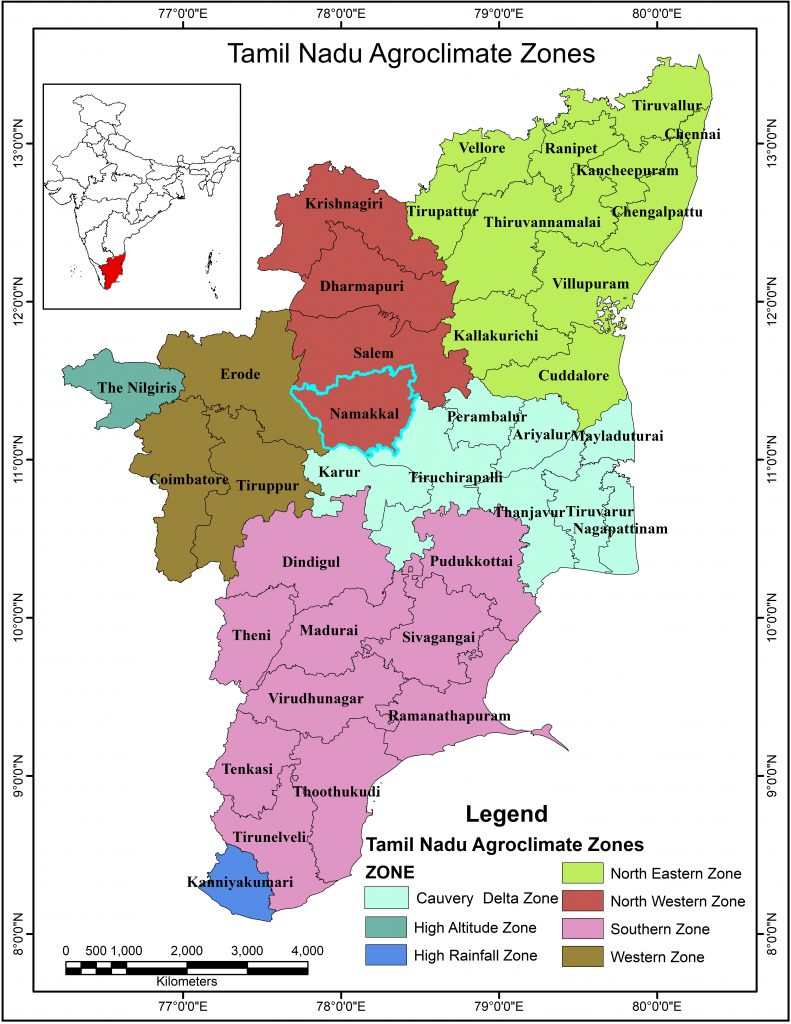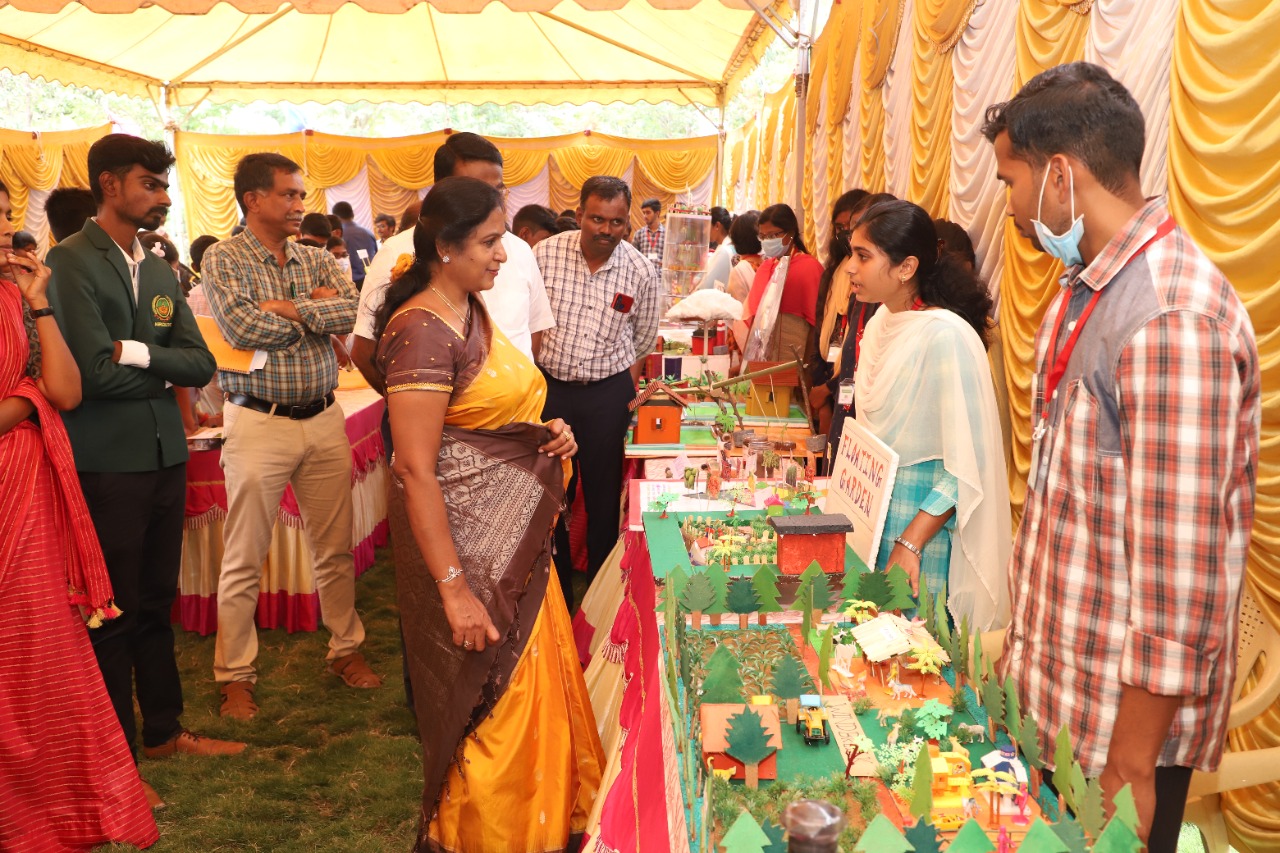The Tamil Nadu Agricultural University (TNAU) had its genesis from establishment of an Agricultural School at Saidapet, Madras, Tamil Nadu, as early as 1868 and it was later relocated at Coimbatore.
Get in touch
- info@tnau.ac.in
- 0422 6611200
- Monday to Friday: 9am to 5pm

Tamil Nadu Agro Climatic Zones
The State of Tamil Nadu has been divided into seven agro-climatic zones to facilitate the university to carry out location specific research. The organizational set up for research consists of one Lead Centre supported by other research stations for each agro-climatic zone. The goal of the university is to serve the state’s farming community to uplift their economic conditions mainly by evolving varieties / hybrids and management practices. With the above aim, TNAU undertakes need based research besides venturing into futuristic research by foreseeing the requirements of the State. TNAU is also keen in adapting technologies from other institutes by fine tuning the same to suit the needs of the State.
Tamil Nadu is the eleventh largest state in India by area. The land area has been classified into seven agro-climatic zones based on soil characteristics, rainfall distribution, irrigation pattern, cropping pattern and other ecological and social characteristics. The following are the seven agro-climatic zones of the State
- North Eastern zone
- North Western zone
- Western zone
- Cauvery delta zone
- Southern zone
- High rainfall zone
- Hill and high altitude zone
Zone |
Districts |
Altitude (m) | Annual rainfall (mm) |
Crops grown |
North Eastern | Kanchipuram, Chengalpet, Tiruvallur, Cuddalore, Villupuram, Kallakuruchi, Vellore, Tirupathur, Ranipet,Tiruvannamalai | 100-200 | 1105 | Rice, Pearl Millet, Sorghum, Gingelly, Finger Millet, Groundnut, Red Gram, Sugarcane, Cashew, Mango, Guards, Green Chillies, Brinjal, Tapioca, Yam, Banana, Jack, Guava, Watermelon, Turmeric, Tube rose, Crossandra and Lemongrass. |
North Western | Dharmapuri, Salem, Namakkal | 200-600 | 875 | Sorghum, Rice, Millet, Groundnut, Horse Gram,Cotton, Sugarcane, Tapioca, Cotton, Gingelly, Chillies, Mango, Banana, Tobacco, Pulses, Jack, Tomato, Radish, Brinjal, Ladies Finger, Pepper, Arecanut, Cocoa, Coconut, Palmarosa, Chrysanthemum, Jasmine, Marigold, Rose, Tuberose, Cutflowers, Turmeric and Red Chillies. |
Western | Erode, Coimbatore, Karur (part), Namakkal (part), Dindigul (part), Theni (part) | 200-600 | 715 | Sorghum, Pulses, Groundnut, Rice, Millets, Cumbu, Cotton, Sugarcane, Ragi, Black Gram, Sunflower, Green Gram, Gingelly, Red Gram, Turmeric, Maize, Banana, Onion, Castor, Tobacco, Guava, Onion, Guards, Tomato, Tea, Coffee, Coconut, Gloriosa, Flowers, Tapioca, Jasmine, Rose and other Vegetables. |
Cauvery Delta Zone (CDZ) | Tiruchi, Perambalur, Pudukottai (part), Thanjavur, Nagapattinam, Mayiladuthurai, Tiruvarur, Cuddalore (part) | 100-200 | 984 | Rice, Cumbu, Maize, Cholam, Ragi, Black Gram, Green Gram, Coconut, Gingelly, Castor, Groundnut, Banana, Onion, Cashew, Betel vine, Citrus, Jack and other Vegetables. |
Southern | Madurai, Sivagangai, Ramanathapuram, Virudhunagar, Tirunelveli, Tenkasi, Thoothukudi | 100-600 | 857 | Rice, Maize, Cumbu, Cholam, Ragi, Black Gram, Greengram, Groundnut, Fodder Crops, Gingelly, Castor, Cotton, Chillies, Banana, Jasmine, Coriander, Onion, Lime, Cashew and Amla. |
High Rainfall | Kanniyakumari | 100-2,000 | 1,420 | Rice, Banana, Jackfruit, Mango, Tapioca, Cashew nut, Coconut, Clove, Vegetables & Tamarind. |
Hilly and High Altitude | Nilgiris, Kodaikanal | > 2,000 | 2,124 | Wheat, Garlic, Lemon, Lime, Pomegranate, Pineapple, Beans, Beetroot, Cabbage, Chowchow, Cotton, Pepper, Coffee, Potato, Banana, Mandarin, Orange, Pear, Cardamom, Cutflowers, Strawberry, Avocado, Tea and Ginger. |
Rainfall and Crops cultivated
North Eastern zone
The North Eastern zone is prone to frequent cyclonic damage. In this zone, 352 mm rainfall normally received during Southwest monsoon season is more adequate and therefore length of growing season accounts to 200 days. Hence, rainfed crops are successfully cultivated in this zone. Groundnut is the most widely cultivated rainfed crop in this zone. Other crops like sesame, sorghum, pearl millet and rainfed rice are also cultivated.
North Western zone
The North Western zone receives 400mm of rainfall through southwest monsoon. Mean maximum temperature ranges from 30°C to 37°C and mean minimum temperature from 19°C to 25.5°C. Length of growing season in this zone is 180 days. Crops such as finger millet, sorghum, groundnut, horse gram, sugarcane, cotton, tapioca and vegetables are widely grown in this zone. Groundnut, sorghum, finger millet, sesame and small millets are grown as rainfed crops.
Western zone
The Western zone receives a mean annual rainfall of 715 mm in 45 rainy days of which 49 percent is received during northeast monsoon season. Mean maximum temperature during April month is 35°C and during January month is 30°C. Mean minimum temperature ranges from 19°C to 24°C. Rice, sugarcane and banana are grown under wetland condition whereas sorghum, groundnut, small millets and pulses are grown as rainfed crops in red soils and cotton, sorghum, bengal gram and sunflower are the rainfed crops in black soils.
Cauvery Delta zone
Annually, a mean rainfall of 984 mm is received in the Cauvery delta zone of which more than 50 per cent is received through Northeast monsoon rains. The predominant crop of this zone is rice. Other crops such as sugarcane and banana are also successfully cultivated in this zone. Sorghum and groundnut are raised as rainfed crops in uplands.
Southern zone
The Southern zone receives a mean annual rainfall of 857 mm in 43 rainy days, of which 400 mm is received through Northeast monsoon rains. The monthly mean maximum temperature ranges from 28°C to 38.5°C and monthly mean minimum temperature ranges from 21°C to 27.5°C. Important crops of this zone are rice, cotton, millets, sugarcane, sunflower, coriander and bengal gram. Sorghum, cotton and sunflower are cultivated as rainfed crops during Northeast monsoon season.
High rainfall zone
The High rainfall zone receives a mean annual rainfall of 1420mm in 64 rainy days. On an average 533, 527, 312 and 47 mm rainfall is received during southwest monsoon, northeast monsoon, summer and winter seasons, respectively, Monthly mean maximum temperature ranges from 28°C to 33°C and monthly mean minimum temperature from 22°C to 26.5°C. Rice is the predominantly grown crop in this zone. Widely cultivated rainfed crop is tapioca. Plantation crops like coconut, rubber, pepper, and cardamom are widely cultivated in this zone. Coconut- arecanut-tapioca is the predominant multi-storeyed cropping system in this zone.
Hill and high altitude zone
This zone covers the Nilgiris, Kodaikanal, Shevroy, Elagir Javadhi, Kollimalai, Pachamalai, Yercaud, Anamalais, Palani and Podhigaimalai. This zone covers an area of 2,549 sq.kms. The area under cultivation is 73,689 hectares which is only 28.9 per cent of the total geographical, area of the zone. Furthermore, only 0.84 per cent of the total cultivated area is the irrigated area i.e., 621 hectares. The annual normal rainfall is 2124 mm. There are no dams for irrigation in this zone since there are no major rivers. Paddy and groundnut are cultivated relatively in less extent. The major crops are tea, coffee and vegetables. Forest area is 1,50,139 hectares which is 58.9 per cent of the total geographical area of the zone.
Nature of Soils
The predominant soils of Tamil Nadu are Entisols, Inceptisols, Alfisols, Ultisols, and Vertisols
Entisols
They cover an area of 18,28,978 ha and distributed in Nilgiris, North Arcot, Erode, Pudukottai, Pasumpon Muturamalingam, Ramanathapuram, South Arcot, Salem, Trichy, Thirunelveli, Thanjavur, Coimbatore, Chengalput, Dharmapuri, Kanyakumari and Kamaraj districts. River alluvium, coastal alluvium and eroded soils are included. They are poor in nitrogen, phosphorus and organic matter but rich in potassium and lime. The River alluvium is used for the cultivation of wetland crops like paddy, sugarcane and banana and Coastal alluvium is used for casuarina plantations. The eroded areas are used for the development of pastures.
Inceptisols
They are distributed in all the districts of Tamil Nadu and cover an area of 22,10,685 ha. Moderately deep red, brown and black soils are included under this category. They are poor in nitrogen, phosphorus, potassium and lime. These soils are used for cultivation sorghum, groundnut, maize, onion, tobacco and chillies.
Alfisols
They cover an area of 31,43,312 ha and are distributed in all the districts except in the hill ranges. They are very deep, reddish in colour and have a well developed sub surface horizon. They are utilized for cultivation of millets and pulses under dryland conditions and groundnut, cotton , maize, sugarcane and paddy under irrigated conditions.
Ultisols
They cover an area of 36,499 ha and are distributed in Salem, Dharmapuri and Nilgiris districts. They are poor in bases. Phosphorus is largely unavailable due to fixation in the soils as iron and aluminium phosphates. They are used for the cultivation of coffee, tea, cocoa, cold vegetable etc.,
Vertisols
They cover an area of 17,91,575 ha and are distributed in all districts except in Nilgiris and Kanyakumari districts. They are very deep, clayey, calcareous and poorly drained. They developed cracks during summer, poor in OM, N and P but fairly well supplied in potassium and lime. Free calcium carbonate is present in the form of canker. Cotton, sorghum and pulses are grown under rainfed conditions. Under irrigated conditions, paddy and cotton are grown.


